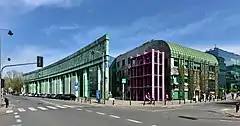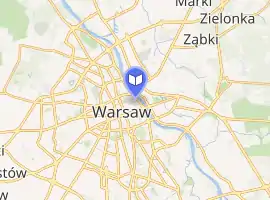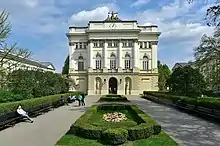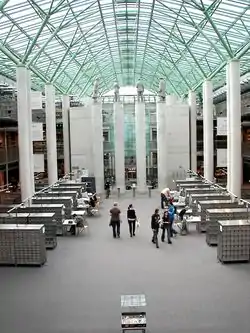University of Warsaw Library
The University of Warsaw Library (Polish: Biblioteka Uniwersytecka w Warszawie, BUW) is a library of the University of Warsaw, Poland.
| Biblioteka Uniwersytecka w Warszawie | |
 | |
 | |
| Type | University library |
|---|---|
| Established | 1816 |
| Location | Warsaw, Poland |
| Coordinates | 52°14′31.32″N 21°01′29.4″E |
| Collection | |
| Size | 3,000,000 |
| Other information | |
| Director | Ewa Kobierska-Maciuszko |
| Public transit access | |
| Website | www |
| Map | |

| |
History

The library was founded in 1816 as a direct consequence of establishing The Royal Warsaw University. Samuel Linde, a linguist, lexicographer, educator and librarian, became its first director. The library initially housed mostly theological and historical Books, the collection was however enlarged by papers from other scientific fields thanks to the right to receive Legal deposits obtained in 1819. In 1831 the library, which served as a public library at that time, already housed 134,000 volumes of books, stored in Kazimierzowski Palace.[1]

After the fall of the November uprising the same year, the institution had been closed, and most of the collection taken away by Russian authorities to Saint Petersburg.[2] In 1862, the University was reinstated in Warsaw under the name of Main School and so was the library, which was renamed as the Main Library.[3] The collection numbered 260,000 book volumes.[1]
In 1871, Main School became the Imperial University of Warsaw[4] and the Main Library fell under the control of that University. The collection was growing constantly, and a much needed new building was constructed in 1891–1894 at Krakowskie Przedmieście. The building was designed to fit one million volumes. Before the outbreak of World War I the collection had grown to 610,000 volumes.[1] During the war some of the most precious books and Manuscripts were taken away to Rostov-on-Don by fleeing tsarist authorities.[5] After the 1921 Treaty of Riga, most of the works were returned to Poland. At the outbreak of World War II, the Library held about one million items. During the war part of the most precious collections, 14% or 130 000 volumes, was damaged by fire.[6] Thanks to the dedicated librarians some of the library's resources survived the war after being walled-in in the basement.[1]
After the war the Library focused mainly on recovering its collections and acquiring new ones from abandoned properties of Germans and Polish nobility. During the first five post-war years, the Library's collection increased by 350 thousand volumes and remained the largest academic library in Poland. Unfortunately communist authorities’ deliberate reduction of funds for the University has automatically caused significant limitations in extending the Library's resources.[1] Until the end of 1990s the Library's poor accommodation situation corresponded with the difficulties in collecting, organising and circulating its collections.
During the 1980s the Library was one of the prominent centres of free thought and activism. The members of anti-communist resistance, including the famous Solidarność movement, were frequent guests to the library.[7]
In the 1990s a selection procedure for a new building was initiated.[8] A design by architects Marek Budzyński and Zbigniew Badowski was chosen,[9] and the new library building was opened on 15 December 1999.[10] Six months before, on 11 June 1999, the building was blessed by Pope John Paul II.[11][12] On 15 June 2001 president of the United States, George W. Bush gave a speech in the new library building to the University community and the residents of Warsaw.[13]
University gardens and architecture
.jpg.webp)
The distinct new building includes a botanical garden, located on the roof. The garden designed by landscape architect Irena Bajerska, has an area of one hectare, and is one of the largest roof gardens in Europe.[14]
It is freely accessible not only to the academia, but also to the public.
The upper part of the garden consists of four parts: the Golden Garden (to the north), the Silver Garden (to the east), the Crimson Garden (to the south) and the Green Garden (to the west). It is available from April to October while from 1 November to 31 March only the Lower Garden is open.
The main facade on the Dobra Street side contains large blocks of classical texts in various scripts, including the Old Polish text of Jan Kochanowski, Classical Greek text by Plato and Hebrew script from the Book of Ezekiel.
References
- "History of the University of Warsaw Library". www.buw.uw.edu.pl. Retrieved 8 January 2021.
- "History of Print Room". www.buw.uw.edu.pl. Retrieved 8 January 2021.
- "Szkoła Główna Warszawska". www.gutenberg.czyz.org. Retrieved 8 January 2021.
- "Polska – dzieje – okres tępienia polskości w zaborze rosyjskim i pruskim". www.gutenberg.czyz.org. Retrieved 8 January 2021.
- "История ЮФУ". sfedu.ru. Retrieved 8 January 2021.
- Majewski, Piotr (2005). Wojna i kultura. Instytucje kultury polskiej w okupacyjnych realiach Generalnego Gubernatorstwa 1939–1945. Warszawa: Wydawnictwo TRI. p. 271. ISBN 8374360038.
- Michalski, Marek (2012). "Poczęty" w BUW: Wspomnienia o Bibliotece Uniwersyteckiej w Warszawie z lat 1977 – 1999. Warszawa: Biblioteka Uniwersytecka. ISBN 9788392482116.
- MP, Alicja (10 July 2010). "BUW na warszawskim Powiślu obchodzi swoje dziesięciolecie". Nasze Miasto (in Polish). Retrieved 8 January 2021.
- Leśniakowska, Marta (2002). Architektura w Warszawie 1989–2001. Warszawa: Arkada Pracownia Historii Sztuki. p. 66. ISBN 83-908950-5-6.
- "Otwarcie nowego gmachu Biblioteki Uniwersytetu Warszawskiego". e-kartka z Warszawy (in Polish). Retrieved 8 January 2021.
- Wizyta Papieża Jana Pawła II at the official website
- Piątek, 11 czerwca 1999 – Podsumowanie siódmego dnia pielgrzymki at Mateusz.pl – Christian web service
- "BUW. Tu pracował Miłosz, przemawiał Bush". PolskieRadio.pl. Retrieved 8 January 2021.
- Ogród at the official website
External links
| Wikimedia Commons has media related to University of Warsaw Library. |